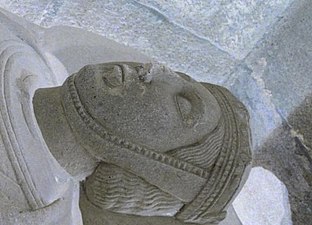Barbette (mode)

La barbette est une légère pièce de lin, portée au Moyen Âge, généralement en même temps qu'un autre couvre-chef. Elle passait sous le menton et était fixée sur les côtés, pour couvrir les oreilles, le cou et parfois le menton, d'où son nom évoquant la barbe[1]. Elle fut principalement portée du XIIe siècle au XIVe siècle, plus rarement au début du XVe siècle.
Galerie[modifier | modifier le code]
- Le Codex Manesse, début du XIVe siècle
Bibliographie[modifier | modifier le code]
- Cumming, Valerie, C.W. Cunnington and P.E. Cunnington. The Dictionary of Fashion History. New York: Berg, 2010.
- Hill, Daniel Delis. History of World Costume and Fashion. Upper Saddle River, NJ: Pearson Prentice Hall, 2011. http://www.worldcat.org/oclc/939043732.
- Lewandowski, Elizabeth J. The Complete Costume Dictionary. Lanham, MD: Scarecrow Press, 2011. http://www.worldcat.org/oclc/694238143.
- Norris, Herbert. Medieval Costume and Fashion. New York: Dover Publications, 1999. http://www.worldcat.org/oclc/987785495.
- Tortora, Phyllis G., and Sara B. Marcketti. Survey of Historic Costume. Sixth edition. New York: Fairchild Books, 2015.
- Jan Seewald: Theatrical Sculpture – Skulptierte Bildnisse berühmter englischer Schauspieler, Herbert Utz Verlag, 2007, S. 147.
- 2. Die Barbe. In: Grammatisch-Kritisches Wörterbuch der Hochdeutschen Mundart. Leipzig, 1793–1801
Références[modifier | modifier le code]
- (de) Cet article est partiellement ou en totalité issu de l’article de Wikipédia en allemand intitulé « Barbette (Mode) » (voir la liste des auteurs).
- Fashion History Timelime (State University of New York), Barbette




